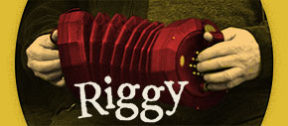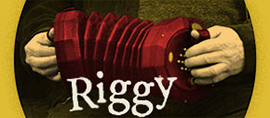
For the past 25-plus years I’ve been playing traditional Irish music on a variety of instruments, including Uilleann pipes, tin whistle, wooden flute, Anglo concertina, and B/C-tuned button accordion.
Since January 2000, I’ve co-hosted the weekly Tuesday night Irish session at The Ould Sod in San Diego, California, as well as being in the hosting rotation for the Sunday afternoon session at The Auld Dubliner in Long Beach, California.
I’ve played Uilleann pipes and Tin Whistle on the soundtracks for two movies, working with composer Patrick Cassidy: “Kill the Irishman” and “Calvary.” I’ve also done studio recording work for the local Southern California band “Sligo Rags” and others.
I have developed a whole family of traditional musical instrument mobile apps for iOS and Android under my AppCordions brand.
My website: MichaelEskin.com
My first exposure to Irish music was The Irish Pipes of Finbar Furey, a Nonesuch album my dad would play when I was a kid.
I had zero intention of ever playing traditional Irish music as a child. I didn’t really discover the music until I was out of college and in my early twenties.


We were a secular Jewish family with no connection to Ireland, but I do remember the sound of Furey playing Uilleann pipes. I grew up playing classical flute from age six and playing in school orchestras and solo competitions through high school. My teacher was the former first chair flautist of the L.A. Philharmonic.

In college, I played baroque and renaissance music on flutes, recorders, and other winds in the Collegium Musicum at San Diego State University. In that group, my wife-to-be played hammered dulcimer for one semester.
After we got out of college, I bought her a used hammered dulcimer off an ad in the local classified. She lost interest in it, but I started playing it. Hammered dulcimer was my primary instrument for about seven years. I used to play weddings, parties, holiday events, and I regularly attended workshops at Swannanoa and Augusta. I had several private students. It was through the hammered dulcimer repertoire where I was first exposed to traditional Irish music, primarily from Karen Ashbrook’s book Playing the Hammered Dulcimer in the Irish Tradition. Pretty much that was going to be what I did, as far as I was concerned, for the rest of my life.
That all changed one day around 1998. I decided to take my smaller dulcimer, a Dusty Strings D10, in a soft case on a Southwest Airlines flight to play at a family event. I arrived at the airport a couple of hours early, got boarding pass #1, was all set to get on the plane, when the gate attendant said, “That won’t fit in the overhead. You have to check it…” Well, we got into a huge argument. I had taken the same instrument on a Southwest 737 before, and I knew it fit, but this little dictator wasn’t going to let me carry it on. So, off it went into the cargo hold (where it survived the flight).
At that moment, I had the thought that ultimately lead to what has happened since: “I need to play something smaller.”
As I was a great fan of the group “Helicon” (Ken Kolodner on hammered dulcimer, Robin Bullock on octave mandolin, Chris Norman on flute), for some reason I decided that octave mandolin was what I was interested in. No idea why I didn’t just go with flute, considering I already played it, but I hadn’t yet been to a session, so I had no idea about Irish flute.

So I bought a nice octave mandolin and played in the local mandolin orchestra for a year while still playing some dulcimer. One day my wife told me that she had read about an “Irish session” at a local bar, The Blarney Stone, and she took me there for my birthday. It was interesting—I remember thinking, “I can do that….” So the next week I showed up with my octave mandolin, a big black orchestral music stand, and a book of tunes. I think I lasted ten minutes before I slunk out the door, quite embarrassed. But convinced I could figure out the tunes, I came back the next week, leaving the music stand at home. Octave mandolin lead to tenor banjo. I also started playing whistle and wooden flute, since I already had the woodwind skills from my flute and recorder days. One of the players in the session at The Blarney Stone was a Scottish piper and had a set of Walsh shuttle pipes in the key of A. I thought they were pretty cool, so I got a set myself and for about a year took Scottish piping lessons. Eventually I thought “what the heck am I doing with this Scottish music?” I sold the shuttle pipes and in 1998 bought my first set of Uilleann pipes, an unplayable full set off of eBay. That lead me to find the Southern California Uilleann Pipers Club, where I got to check out some real sets and get some instruction. In early 2000, I got the heart of my current set, a Kirk Lynch half-set.
I later added two regulators from Kirk and switched to a Benedict Koehler chanter. In 2000 I started co-hosting the Tuesday night session at The Ould Sod here in San Diego along with my co-host fiddler George Rubsamen. The session, other than some breaks we’ve had to take for COVID-19 mitigation, is still happening every week.
I’ve also bought and sold a few nice wooden flutes over the years. One of these sales—I believe it was a 4-key blackwood Terry McGee which I put up for sale after I got my restored 8-key Metzler (my current keyed flute)—was to Bob Tedrow, who wanted to buy an Irish flute for his daughter and offered to trade me one of his 30-button C/G Anglo concertinas. I figured, “Sure, why not.”


Worst case scenario was that I wouldn’t be able to figure it out and would have to sell it. I didn’t sell it. I really enjoyed the challenge of putting tunes on it. So that started me down the Anglo concertina path. At the suggestion of a local player, very soon after I got the Tedrow, I attended the Noel Hill workshop several times, on both east and west coasts, and now have been playing the instrument for 15-plus years. My primary instrument is a Wally Carroll Noel Hill model. In 2011, the company I’d been working for over 20 years was starting to become unstable, so I decided I’d better build a lifeboat. I learned to write musical instrument emulation apps for iOS, the first being a set of virtual regulators for Uilleann pipes. I also developed both English and Anglo concertina apps. At some point, I decided to write a 3-row accordion app.

Hohner really liked the app since it sounded a lot like a Corona, and they made me a mutually beneficial, simple branding deal that still exists to this day. I ended up writing 1-, 2-, and 3-row diatonic accordion apps, piano accordion apps, and chromatic button accordion apps. I had a pretty good feeling that the apps were a very inexpensive way a new player could have an experience of playing the instrument before purchasing a real one, so I decided to “eat my own dog food” and took on learning B/C box from my own 2-row iPad accordion app. After a few months of playing tunes on the iPad app, I asked Hohner if they would provide me with a real instrument, one of the modern “black-dot” B/C instruments. Turns out it worked, and I was very quickly able to start playing tunes on the real box, leveraging my experience with my app. Fast forward nine years and now I’m practicing B/C box every day, playing it in sessions along with Anglo concertina and flute when I don’t want to bring my pipes.
I’ve got a whole collection of the things now. It’s only been since COVID-19 shut everything down that I’ve really started woodshedding on the box. It’s been wonderful, and I have had the opportunity to do a lot of work with John Whelan, helping to co-host his Zoom sessions and group lessons, writing up detailed transcriptions of his playing for the lessons, and managing all the recording of the events, which give me access to something like 80 hours of his playing. If I had not had that fight with the Southwest gate attendant, there is a very good chance I’d still be playing only hammered dulcimer. It’s been quite the ride, and none of it was planned.


My family on both sides is originally from the Ukraine, near Kiev. My paternal grandmother and all of the great uncles and aunts (their last name was Levitsky) on her side spoke Yiddish as well as English. They emigrated to New York in the 1920s. My grandmother Elizabeth and her sister Esther played piano, and my great uncles Charlie and Henry were both concert violinists. Music was a constant presence when I’d visit them, but none of it was Irish. They all passed away before I ever played a note of Irish music.

In high school, I was the first-chair flute player in the orchestra for several years, and I played first flute/piccolo in the pit orchestra for Fiddler on the Roof one year. I lived in North Hollywood, and a lot of kids at my high school were Jewish.
I started taking silver flute lessons at age six. Before then, my parents played some recorder, so I had some experience on that as well as a child. I still have their Adler pearwood/ivory recorders from that era. I took lessons through high school, the last five years or so with a former first chair of the L.A. Philharmonic. I was also in several flute choirs she organized, and I competed regularly in various solo competitions that were organized by whatever music teachers’ association she was with. One year I won, playing Edgar Varèse’s “Density 21.5,” and I was invited to Sacramento to play the piece for the state music teachers’ convention.
Proud moment? Probably performing a set with Kevin Crehan, Junior Crehan’s grandson, who lives in L.A., at a house concert here in San Diego a few years ago. We were playing tuned down to B, and I was playing Junior Crehan’s Jeffries concertina tuned in A/E.
Another proud moment was when I first heard my playing on the Patrick Cassidy soundtrack for the movie Kill the Irishman in a theater. I contributed to two movie soundtracks he arranged and composed—Kill the Irishman, where I played Uilleann pipes, wooden flute, and whistles, and Calvary.

